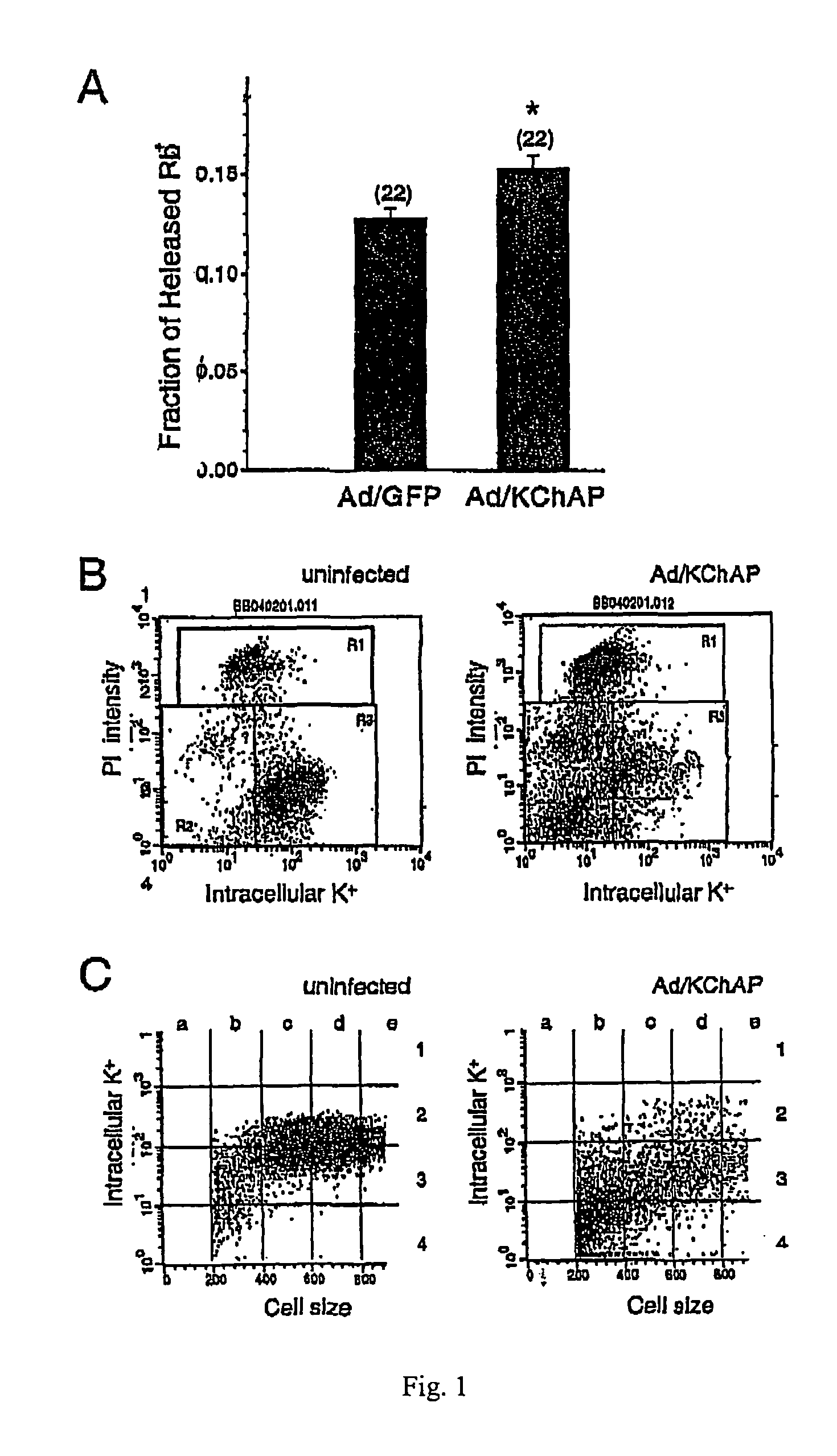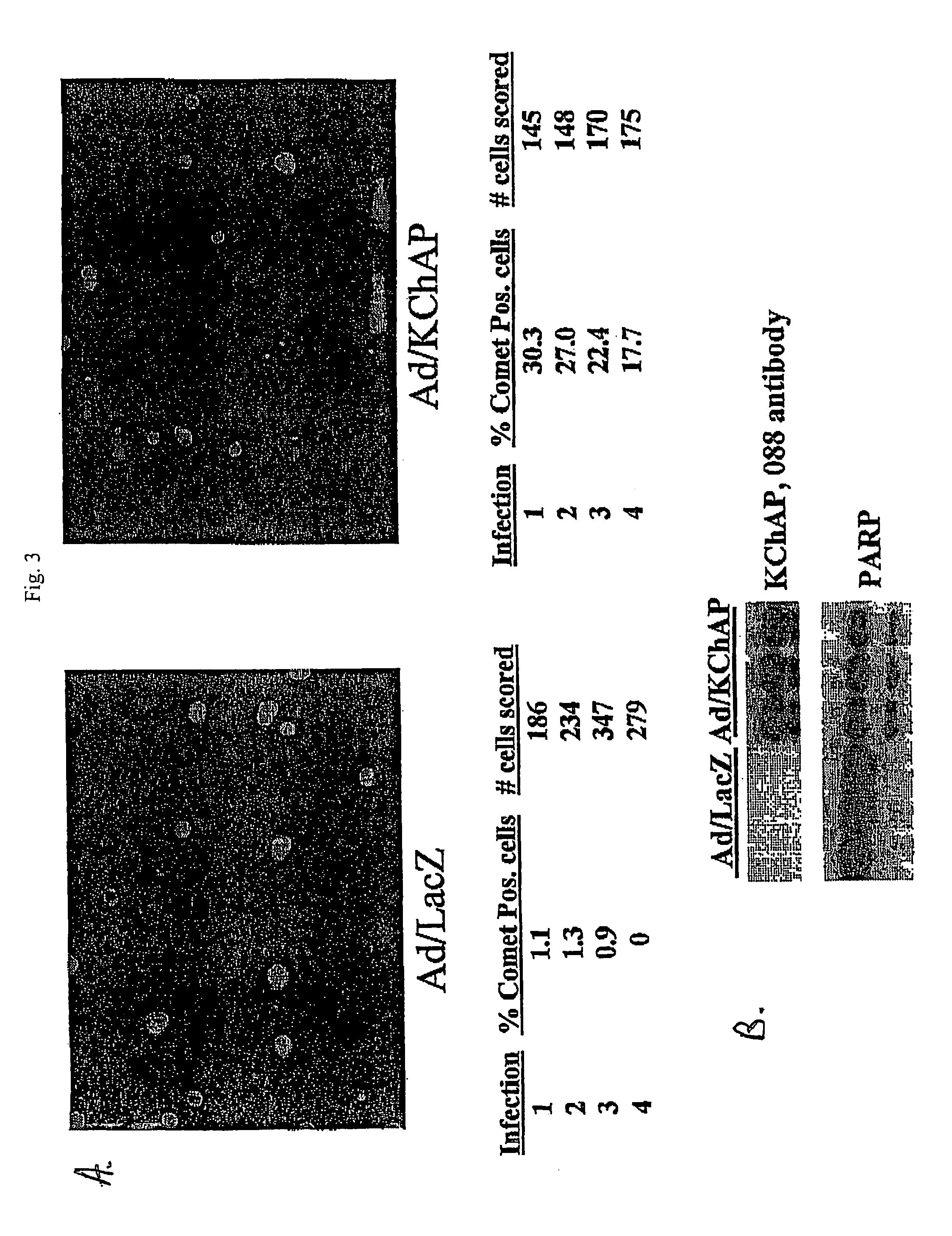Methods of inducing apoptosis in hyperproliferative cells
a technology of hyperproliferative cells and apoptosis, which is applied in the direction of peptide/protein ingredients, drug compositions, peptide sources, etc., can solve the problems of insufficient resectability, radioisotope therapy can induce extensive damage to normal tissues, tumors cannot be treated with radiotherapy, etc., and achieve the effect of increasing the level of kchap protein
- Summary
- Abstract
- Description
- Claims
- Application Information
AI Technical Summary
Benefits of technology
Problems solved by technology
Method used
Image
Examples
example 1
KChAP Overexpression of in Prostate Cancer Cells
KChAP increases K+ Efflux in LNCaP Cells
[0105]To examine the effect of increased intracellular levels of KChAP on K+ flux, LNCaP cells were infected with either Ad / GFP or Ad / KChAP (moi of 100) for 24 hours after which they were loaded with the potassium surrogate rubidium (Rb+) and assayed for Rb+ release by flame atomic absorption spectroscopy. LNCaP are a model cell line for prostate cancer cells which comprise native or wild-type p53 protein. As shown in FIG. 1A, KChAP—overexpressing cells showed a significant increase (about 20%) in the fraction of Rb+ released compared to cells infected with a GFP virus. In a 10 minute period, about 12.5% of the loaded Rb+ was released from Ad / GFP infected cells whereas over 15% was released from cells infected with Ad / KChAP.
[0106]The relative amount of K+ in Ad / KChAP-infected cells was measured at later times after infection using flow cytometry with the potassium sensitive dye, PBFI. LNCaP cells...
example 2
Inducing Apoptosis in Prostate Cancer Cells Comprising a Mutated p53 Protein by Increasing Intracellular Levels of KChAP
[0116]To determine whether wild-type p53 is essential for KChAP effects, we tested the effects of in a cell line with mutant p53. The prostate cancer cell line, Du145, has p53 with several point mutations rendering it nonfunctional as a transcription factor (ref). Du145 cells were infected with Ad / GFP or Ad / KCHAP at two different m.o.i. (200 and 400) and lysates prepared 72 hours after infection. Greater than 95% of the cells were infected in these experiments as determined by GFP fluorescence and most of the infected cells were floating by day 3 (data not shown). Western blotting shows significant PARP cleavage in Du145 cells infected with Ad / KChAP compared to control, Ad / GFP infected cells (FIG. 7). Steady-state p53 levels are already high in Du145 cells as is often seen when p53 is mutated, and those levels do not increase with KChAP overexpression. The phosphor...
example 3
Inhibiting In Vivo Growth of Subcutaneous Implants of Human Prostate Cancer Cells by Increasing Intracellular Levels of KChAP
[0117]We have shown that KCHAP is a potent inducer of apoptosis in cell lines with diverse p53 status. To assess its potential usefulness as an anticancer agent, we created subcutaneous tumors in nude mice by injecting either Du145 or LNCaP cells into the flank area. Du145 cells, mixed with matrigel, formed well established tumors in the flanks of nude mice in about two weeks. Once tumors were established, Ad / KChAP was injected directly into the tumors every 48-72 hours for a total of 9 injections over a period of 19 days. Two batches of control tumors were injected with either PBS or Ad / GFP. As shown in FIG. 8A, injection of Ad / KChAP significantly suppressed the growth of Du145 tumors compared with Ad / GFP or PBS treatments. In the animals treated with Ad / KChAP, the mean tumor volume was 81 mm3 after 19 days (n=8). In contrast, the mean tumor volume reached 49...
PUM
| Property | Measurement | Unit |
|---|---|---|
| Level | aaaaa | aaaaa |
| Hyperproliferative | aaaaa | aaaaa |
Abstract
Description
Claims
Application Information
 Login to View More
Login to View More - R&D
- Intellectual Property
- Life Sciences
- Materials
- Tech Scout
- Unparalleled Data Quality
- Higher Quality Content
- 60% Fewer Hallucinations
Browse by: Latest US Patents, China's latest patents, Technical Efficacy Thesaurus, Application Domain, Technology Topic, Popular Technical Reports.
© 2025 PatSnap. All rights reserved.Legal|Privacy policy|Modern Slavery Act Transparency Statement|Sitemap|About US| Contact US: help@patsnap.com



